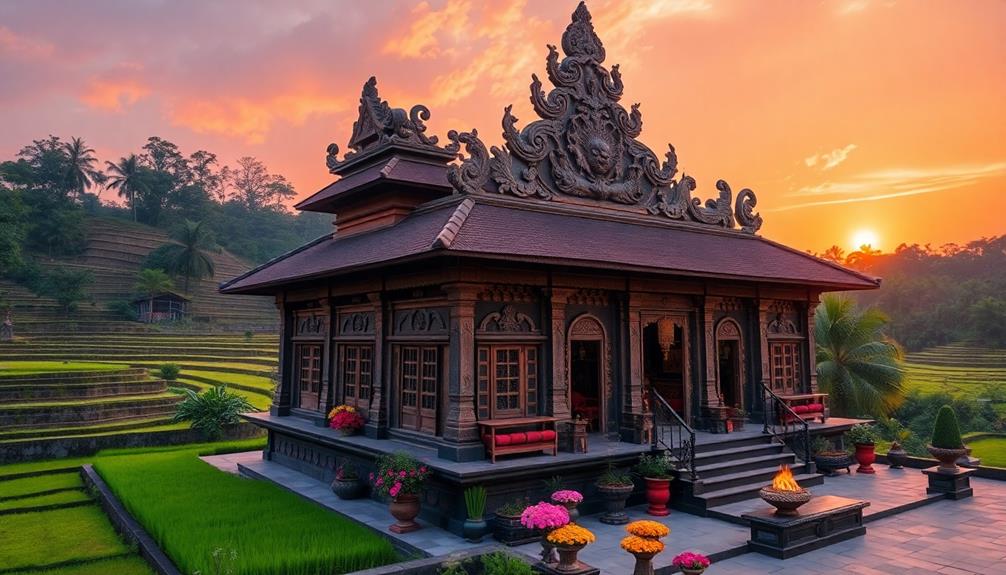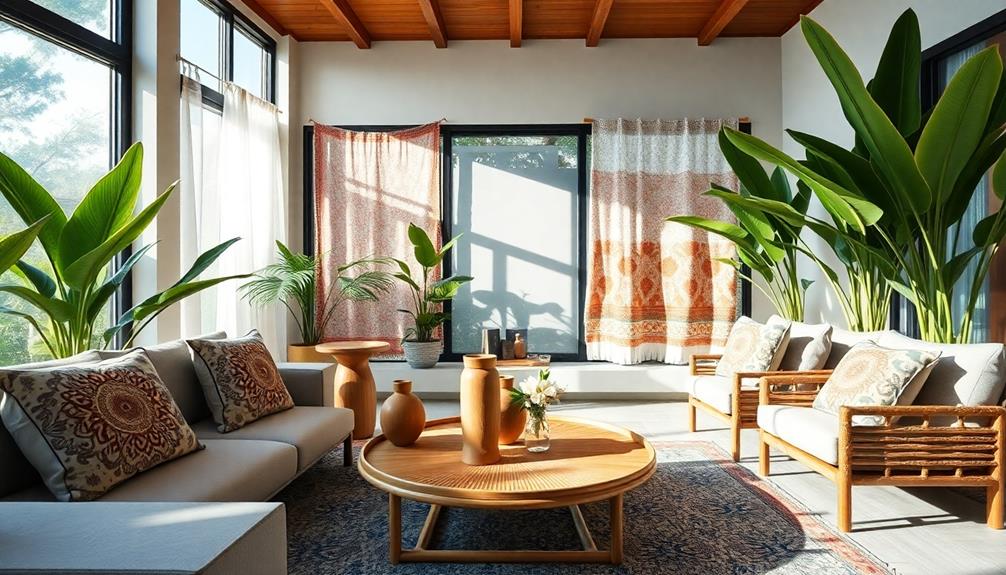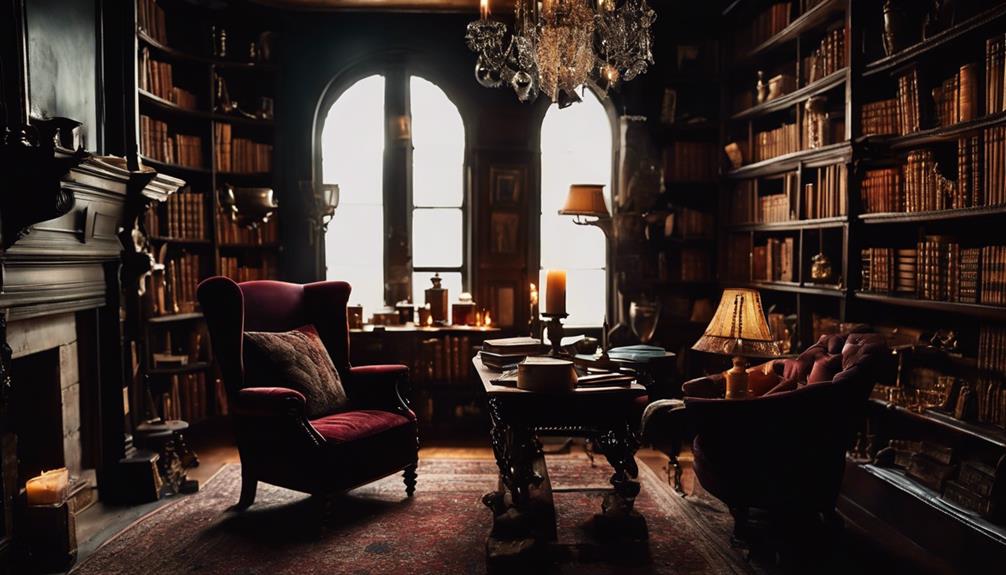Balinese design motifs hold cultural importance because they weave together spirituality, history, and community identity. Each intricate pattern tells a story, often inspired by local myths and Hindu epics, connecting you to Bali's heritage. Symbols like the lotus flower and mythical creatures represent purity and divine protection. These motifs create harmony within spaces, fostering tranquility and a connection to nature. They also strengthen community ties during rituals and ceremonies, linking generations. By understanding these designs, you can appreciate how they enrich everyday life, revealing the depth of Balinese culture and its continuing influence on the modern world.
Key Takeaways
- Balinese design motifs embody spiritual beliefs, connecting communities to their Hindu-Buddhist heritage and fostering a sense of identity and belonging.
- Each motif narrates stories from local myths and historical events, preserving cultural history and traditions across generations.
- Symbols like lotus flowers and mythical creatures provide spiritual protection and represent purity, enhancing the cultural significance of designs.
- Intricate craftsmanship and vibrant colors in motifs reflect Balinese artistry and the community's connection to nature and the divine.
- The integration of traditional motifs into modern design promotes cultural continuity, ensuring that ancestral connections are maintained in contemporary contexts.
Spiritual Connections in Design
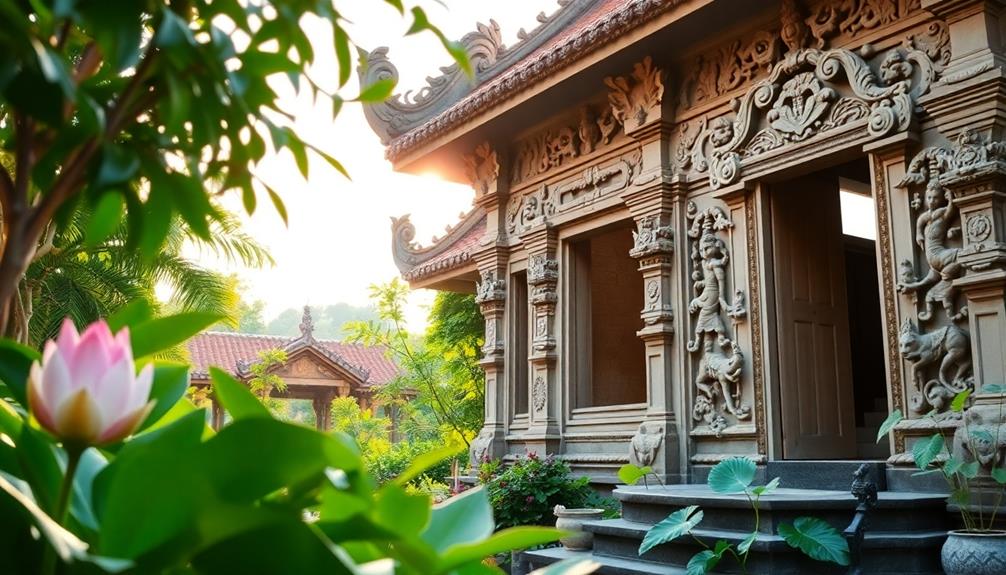
In Balinese design, you'll find that spiritual connections are deeply woven into every motif. The intricate carvings and patterns reflect the rich Balinese culture, emphasizing harmony with nature and the spiritual dimension. You'll notice symbols like lotus flowers and mythical creatures that embody purity and the connection to the divine. Each motif serves not just as decoration but as a narrative, inspired by local myths and Hindu epics, reinforcing spiritual teachings through visual storytelling.
Additionally, these motifs often reflect the principles of Balinese interior design concepts, creating spaces that foster tranquility and connection to the environment.
As you explore Balinese art and architecture, you'll see how these motifs are integral to daily life. Ritual offerings and decorative elements are crafted with specific designs believed to attract positive energy and blessings from the gods. This practice highlights the importance of spirituality in everyday activities, ensuring that the community remains connected to their heritage.
You'll also find these motifs in household items and temple designs, creating a continuous reminder of the spiritual ties that bind the Balinese people to their environment. This deep-rooted belief system fosters a unique cultural identity, enabling you to appreciate the layers of meaning in every piece of Balinese design you encounter.
Symbolism and Meaning

Balinese design motifs burst with symbolism and meaning, each element carefully chosen to convey deeper messages. In Balinese Hinduism, symbols like the lotus flower represent purity and enlightenment, reflecting the spiritual journey of individuals.
You'll notice intricate carvings of mythological creatures such as Garuda and Barong, which embody cultural narratives and provide spiritual protection to the community. These motifs often draw inspiration from traditional art forms, such as Indonesian decor masks, showcasing vibrant artistry that reflects the rich culture.
Geometric patterns in these designs demonstrate the philosophy of Tri Hita Karana, emphasizing the importance of harmony and balance among God, people, and nature. The vibrant colors in textiles and carvings aren't just for aesthetics; each shade carries specific meanings. For instance, red symbolizes bravery and strength, while white stands for purity and peace.
Additionally, traditional motifs play significant roles in ceremonies, such as offerings and temple decorations, reinforcing their significance in religious practices and community identity.
Historical Context of Motifs
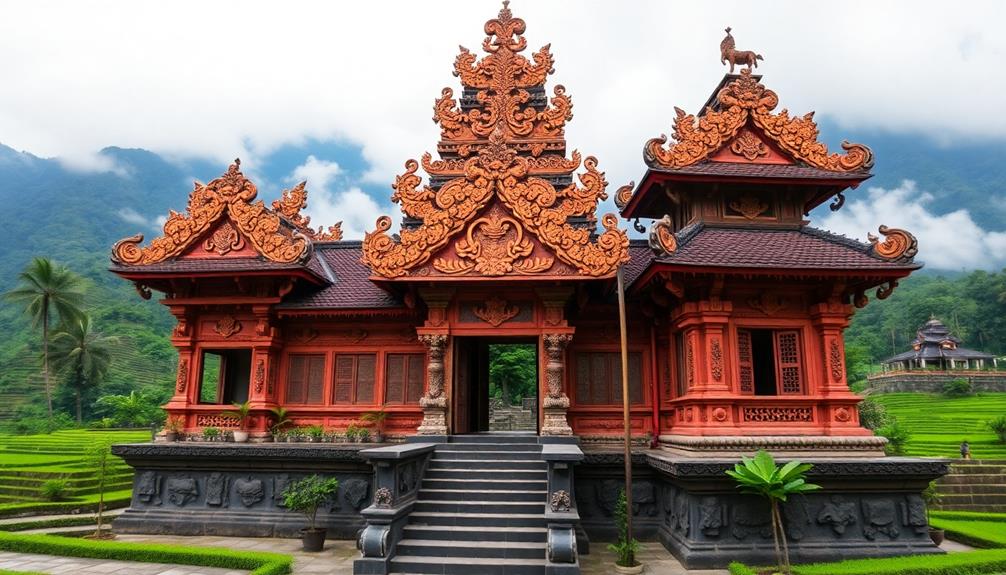
When you explore the historical context of Balinese design motifs, you'll find their roots tracing back to early A.D. and the influence of Hindu-Buddhist culture.
These motifs not only reflect the island's spiritual heritage but also carry rich symbolism that narrates stories from Hindu epics.
The intricate carvings and handcrafted furniture often seen in traditional Indonesian decor underscore how these motifs are celebrated within various elements of design, including Indonesian Decorative Pillows that enhance living spaces.
As you consider the evolution of these designs, you'll see how they adapt while preserving their deep cultural significance.
Origins of Design Motifs
Drawing from centuries of cultural evolution, the origins of Balinese design motifs reveal a rich tapestry of spiritual and artistic expression. These motifs first emerged from Hindu-Buddhist influences, tracing back to the early A.D. period.
As you explore the history, you'll notice that the Majapahit empire in the 14th century played a crucial role in shaping these designs, blending Javanese culture with existing Balinese traditions. Many of these motifs can be seen in traditional crafts, such as the intricate Indonesian decor masks, which represent the rich cultural heritage of the region.
Traditional motifs often depict mythological creatures, intricate floral patterns, and themes from Hindu epics. These elements serve not just aesthetic purposes; they also hold significant religious meaning in temples and daily life. You can see how these motifs have preserved cultural identity, especially during the Islamic influence in the 16th century, when Balinese artists actively sought to retain their heritage.
Moreover, distinctive motifs vary by region. For instance, in Ubud, you'll find elaborate paintings, while Mas village is renowned for its intricate wood carvings.
Each area showcases unique historical and cultural narratives, enriching the overall landscape of Balinese design and ensuring that these motifs remain a crucial part of the island's identity.
Symbolism in Balinese Art
The rich tapestry of Balinese design motifs is deeply intertwined with the symbolism embedded in its art. These intricate designs reflect the island's spiritual beliefs, primarily influenced by Hinduism and Buddhism. Each motif tells a story and serves a purpose, connecting you to the cultural heritage of Bali.
| Motif | Symbolism | Historical Context |
|---|---|---|
| Lotus Flower | Purity and spiritual awakening | Used in various religious ceremonies |
| Barong Figure | Spirit of good | Represents the battle between good and evil |
| Garuda Bird | Strength and protection | Linked to both Hindu and Buddhist texts |
| Koi Fish | Perseverance and courage | Often seen in temple decorations |
Understanding these symbols enriches your appreciation for Balinese art, revealing that these motifs are not just aesthetic expressions. Instead, they embody essential connections to community practices and cultural identity. The evolution of these motifs over centuries showcases how Balinese art adapts while preserving its essence, making it a living reflection of the island's vibrant cultural heritage.
Influence of Nature

Throughout history, Balinese design motifs have been deeply influenced by nature, showcasing the island's vibrant flora and fauna. You'll notice that intricate representations of leaves, flowers, and animals often adorn temple carvings and textiles, reflecting the rich biodiversity of Bali. These motifs symbolize harmony and respect for the environment, reminding you of the island's spiritual connection to nature.
The incorporation of traditional Indonesian style home decor further emphasizes this connection, as artisans skillfully blend natural materials into their designs.
The philosophy of Tri Hita Karana plays a significant role here, emphasizing the balance between humans, nature, and the divine. This balance is a core principle that shapes the motifs seen in Balinese art and architecture. Many designs draw inspiration from local legends and myths, highlighting the importance of natural landscapes and elements, which reinforces the community's cultural identity.
Moreover, the use of natural materials like bamboo and stone in combination with these motifs enhances the harmony between the built environment and its surroundings. By incorporating nature into their art, Balinese artisans create a visual dialogue that honors the island's beauty while fostering a deep sense of respect for the world around them.
It's this profound relationship that makes Balinese design motifs culturally significant.
Artistic Techniques and Craftsmanship
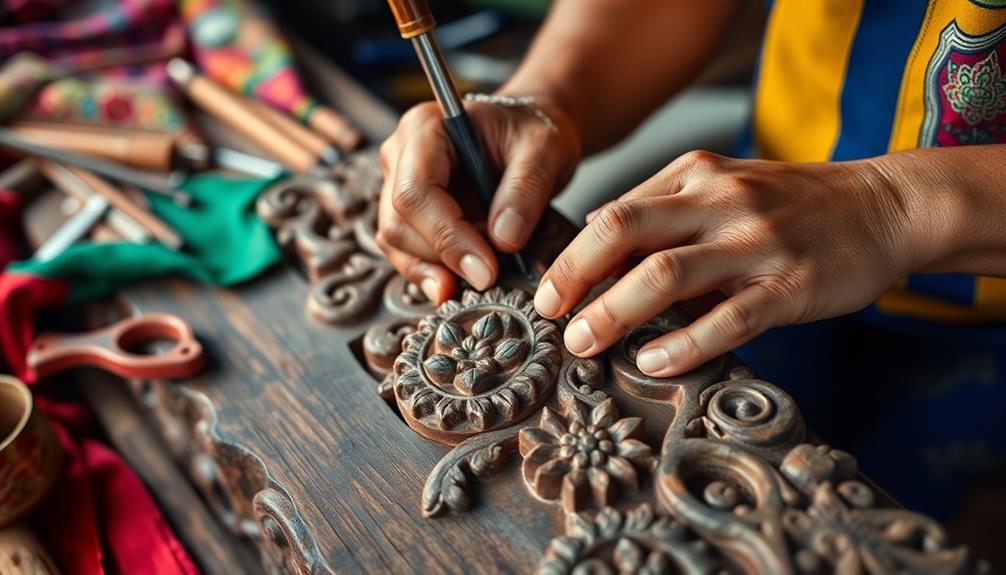
Balinese design motifs captivate with their intricate carvings and vibrant colors, showcasing the island's rich cultural heritage and spiritual beliefs. The artistic techniques employed by Balinese artisans are truly remarkable, reflecting centuries of craftsmanship.
In villages like Mas, skilled wood carvers meticulously create detailed sculptures, using methods passed down through generations. Additionally, the use of high-quality materials sourced locally enhances the authenticity of these designs, as seen in luxury tropical designs offered by local interior shops.
Traditional paintings often illustrate mythological scenes and daily life, utilizing natural pigments sourced from local materials to produce unique artistic expressions. This commitment to authenticity enhances the cultural narrative behind each piece.
Batik, another significant medium, employs symbolic patterns that not only tell stories but also highlight a spiritual connection inherent in Balinese design. Recognized by UNESCO as an Intangible Cultural Heritage, batik showcases intricate dyeing processes that require immense skill and patience.
Artisans also incorporate gold leaf application in wood carving, adding a touch of elegance and vibrancy to their work.
Preservation of Cultural Heritage

When you explore Balinese design motifs, you uncover their rich historical significance and the deep symbolic meanings woven into the art.
These motifs not only reflect the island's spiritual heritage but also influence modern design, creating a bridge between past and present.
Traditional Indonesian housing, known as Rumah Adat, showcases similar cultural symbolism that enriches the architectural landscape.
Historical Significance of Motifs
Many traditional Balinese design motifs hold deep historical significance, serving as essential links to the island's rich cultural heritage. These motifs, rooted in Hindu-Buddhist culture and influenced by the Javanese during the Majapahit empire, reflect the spiritual beliefs and narratives of the Balinese people. Each intricate carving and pattern represents not just art, but a means of preserving ancestral connections and natural elements.
For instance, the use of vibrant floral displays in Indonesian wedding decor ideas often draws inspiration from these motifs, enhancing the cultural experience of ceremonies.
- They embody stories of deities and historical events, connecting generations.
- Rituals and ceremonies tied to these motifs strengthen community bonds.
- UNESCO's recognition elevates Bali's cultural heritage on a global stage.
Through these motifs, the Balinese people maintain a continuity of cultural practices, ensuring that the richness of their history isn't lost.
Every design serves as a reminder of their identity, beliefs, and the importance of community. By understanding the historical significance of these motifs, you appreciate the depth of Bali's artistry and the resilience of its cultural traditions.
Embracing this heritage allows you to connect with the island's past while fostering a sense of pride in its ongoing story.
Symbolic Meanings in Art
Art in Bali isn't just about aesthetics; it's steeped in symbolic meanings that reflect the island's cultural heritage. Balinese design motifs often draw inspiration from Hindu epics, incorporating symbols like lotus flowers and mythical creatures. These elements represent spiritual beliefs and a profound connection to the divine, enriching the art's significance.
Additionally, some motifs resonate with the vibrant tradition of Indonesian decor masks, which embody rich cultural narratives and storytelling, enhancing the overall appreciation for Indonesian artistry and craftsmanship cultural storytelling aspect.
The intricate carvings and patterns found in Balinese art serve to preserve cultural narratives, showcasing historical stories and community values passed down through generations. Each village boasts its unique artistic style, adding to the rich tapestry of cultural heritage and illustrating the diversity within Balinese art.
Moreover, traditional motifs play an essential role in local rituals and ceremonies, reinforcing community bonds and collective memory. This connection guarantees that the symbolic meanings in art remain relevant, even as contemporary designs emerge. By embracing these motifs, you help maintain a sense of identity and continuity, preventing the loss of cultural heritage amid modernization.
Ultimately, Balinese design motifs not only attract global interest but also invite you to appreciate the depth and richness of a culture steeped in history and tradition.
Influence on Modern Design
Balinese design motifs thrive in modern design, seamlessly blending traditional elements with contemporary aesthetics. By incorporating these motifs, designers not only create stunning visuals but also preserve the island's rich cultural heritage. The intricate carvings and vibrant patterns reflect the spirit of Tri Hita Karana, emphasizing harmony between God, nature, and humanity.
This integration promotes modern tropical aesthetics that enhance airflow, light, and sustainable living.
- Feel the pulse of tradition in every modern piece.
- Experience the connection between past craftsmanship and today's innovations.
- Celebrate the vibrant identity of Indonesia through design.
In today's global landscape, Balinese motifs aren't just decorative; they're culturally important symbols of identity and creativity. The UNESCO designation of Balinese batik as an Intangible Cultural Heritage of Humanity underscores this significance.
When you see these motifs in architecture and fashion, you're witnessing a dialogue between past and present. Designers are actively engaging with these traditions, fostering appreciation and awareness of Balinese culture.
Impact on Community Identity

In the heart of Bali, design motifs serve as powerful symbols that shape community identity and foster a shared sense of belonging. These motifs incorporate local beliefs, spirituality, and nature's harmony, reinforcing your community's identity and shared values.
They're not just decorative; they're integral to traditional ceremonies and rituals, acting as visual narratives that unite everyone during significant life events.
By embracing distinct motifs in art and architecture, you cultivate pride and a sense of belonging, distinguishing your cultural identity from neighboring regions. Each community often specializes in specific motifs and artistic styles, enhancing local craftsmanship and promoting cultural tourism.
This specialization not only showcases the richness of Balinese culture but also strengthens regional identities.
Moreover, the preservation and transmission of these traditional motifs through generations guarantee cultural continuity. This process fosters intergenerational connections, allowing you to pass down shared histories and values.
Ultimately, Balinese design motifs are culturally important, as they weave together the fabric of your community, reflecting its unique identity and reinforcing a collective bond that thrives through time.
Frequently Asked Questions
What Is the Purpose of Balinese Art?
Balinese art serves to express spiritual beliefs and cultural identity. It connects you to local narratives, reinforces community bonds, and acts as a medium for worship, promoting harmony and preserving the island's rich heritage.
What Is the Balinese Architecture Culture?
Did you know that over 80% of Balinese architecture adheres to traditional principles? You'll find its culture deeply rooted in spirituality, utilizing natural materials and intricate designs that express harmony with nature and community identity.
What Is the Essence of Balinese Culture?
Balinese culture's essence lies in its harmonious blend of spirituality, community, and tradition. You'll find vibrant rituals, deep respect for nature, and close-knit relationships, all reflecting the island's unique identity and rich heritage.
What Are the Cultural Values of Bali?
You'll find that Bali's cultural values emphasize harmony, community, and spirituality. Daily offerings, communal rituals, and respect for nature reflect these beliefs, fostering connections among people, their environment, and the divine in everyday life.
Conclusion
To sum up, Balinese design motifs are more than just beautiful patterns; they're the heartbeat of a vibrant culture. These intricate symbols connect you to the spiritual and natural worlds, weaving history into every thread. As you embrace these designs, you're not just appreciating art—you're participating in a living legacy that defines community identity. The preservation of these motifs is like safeguarding a treasure chest overflowing with the wisdom of generations, ensuring that their rich story continues to thrive.
